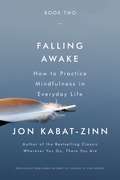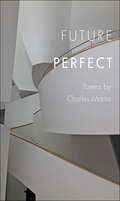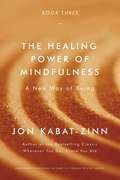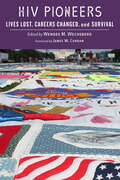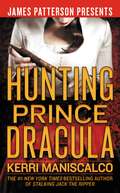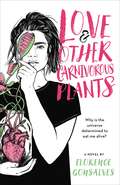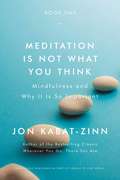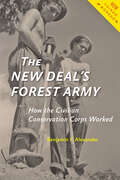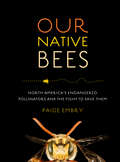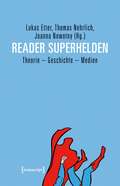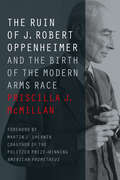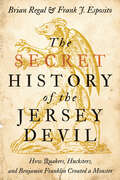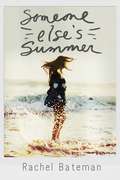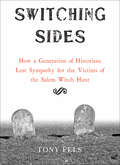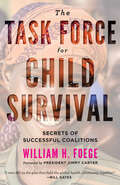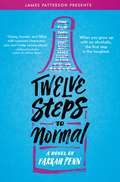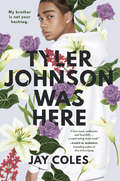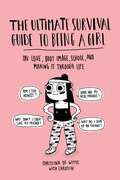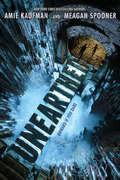- Table View
- List View
Falling Awake: How to Practice Mindfulness in Everyday Life
by Jon Kabat-ZinnThink you have no time for mindfulness? Think again. "Thoughtful and provocative.... The relevance of this work is unquestionable, as it leaves us inspired and optimistic that true healing really is possible" (Sharon Salzberg). For four decades, Jon Kabat-Zinn has been teaching the tangible benefits of meditation in the mainstream. Today millions of people have taken up a formal mindfulness meditation practice as part of their everyday lives. But how do you actually go about meditating? What does a formal meditation practice look like? And how can we overcome some of the common obstacles to incorporating meditation into daily life in an age of perpetual self-distraction? Falling Awake directly answers these urgent and timely questions. Originally published in 2005 as part of a larger book titled Coming to Our Senses, it has been updated with a new foreword by the author and is even more relevant today. Science shows that the tangible benefits of a mindfulness meditation practice are impossible to ignore. Kabat-Zinn explains how to incorporate them into our hectic, modern lives. Read on for a master class from one of the pioneers of the worldwide mindfulness movement.
Future Perfect (Johns Hopkins: Poetry and Fiction)
by Charles MartinTo be modern is to live not in a single era, but in a churn of new technologies, deep history, myth, literary traditions, and contemporary cultural memes. In Future Perfect, Charles Martin;€™s darkly comic new collection, the poet explores our time and the times that come before and after, which we inhabit and cultivate in memory and imagination. Through poems that play with form and challenge expectation, Martin examines the continuities that persist from time immemorial to the future perfect.Sensitive to the traces left behind by the lives of his characters, Martin follows their tracks, reflections, echoes, and shadows. In "From Certain Footprints Found at Laetoli," an ancient impression preserved in volcanic ash conjures up a family scene three million years past. In "The Last Resort of Mr. Kees" and "Mr. Kees Goes to a Party," Martin adopts the persona of the vanished poet Weldon Kees to reimagine his disappearance. "Letter from Komarovo, 1962" retells the tense real-life meeting between Anna Akhmatova and Robert Frost a year before their nations almost destroyed one another. And in the titular sonnet sequence that ends the book, Martin conjures a childhood in the Bronx under the shadow of the mushroom cloud of nuclear war as the perfected future supplanting the present.Introducing Buck Rogers to Randall Jarrell and combining new translations or reinterpretations of works by Ovid, G. G. Belli, Octavio Paz, and Euripides, Future Perfect further establishes Charles Martin as a master of invention.
Future Perfect (Johns Hopkins: Poetry and Fiction)
by Charles MartinTo be modern is to live not in a single era, but in a churn of new technologies, deep history, myth, literary traditions, and contemporary cultural memes. In Future Perfect, Charles Martin;€™s darkly comic new collection, the poet explores our time and the times that come before and after, which we inhabit and cultivate in memory and imagination. Through poems that play with form and challenge expectation, Martin examines the continuities that persist from time immemorial to the future perfect.Sensitive to the traces left behind by the lives of his characters, Martin follows their tracks, reflections, echoes, and shadows. In "From Certain Footprints Found at Laetoli," an ancient impression preserved in volcanic ash conjures up a family scene three million years past. In "The Last Resort of Mr. Kees" and "Mr. Kees Goes to a Party," Martin adopts the persona of the vanished poet Weldon Kees to reimagine his disappearance. "Letter from Komarovo, 1962" retells the tense real-life meeting between Anna Akhmatova and Robert Frost a year before their nations almost destroyed one another. And in the titular sonnet sequence that ends the book, Martin conjures a childhood in the Bronx under the shadow of the mushroom cloud of nuclear war as the perfected future supplanting the present.Introducing Buck Rogers to Randall Jarrell and combining new translations or reinterpretations of works by Ovid, G. G. Belli, Octavio Paz, and Euripides, Future Perfect further establishes Charles Martin as a master of invention.
The Healing Power of Mindfulness: A New Way of Being
by Jon Kabat-ZinnDiscover how mindfulness can help you with healing. More than twenty years ago, Jon Kabat-Zinn showed us the value of cultivating greater awareness in everyday life with his now-classic introduction to mindfulness, Wherever You Go, There You Are. Now, in TheHealing Power of Mindfulness, he shares a cornucopia of specificexamples as to how the cultivation of mindfulness can reshape your relationship with your own body and mind--explaining what we're learning about neuroplasticity and the brain, how meditation can affect our biology and our health, and what mindfulness can teach us about coming to terms with all sorts of life challenges, including our own mortality, so we can make the most of the moments that we have. Originally published in 2005 as part of a larger book titled Coming to Our Senses, The Healing Power of Mindfulness features a new foreword by the author and timely updates throughout the text. If you are interested in learning more about how mindfulness as a way of being can help us to heal, physically and emotionally, look no further than this deeply personal and also "deeply optimistic book, grounded in good science and filled with practical recommendations for moving in the right direction" (Andrew Weil, MD), from one of the pioneers of the worldwide mindfulness movement.
HIV Pioneers: Lives Lost, Careers Changed, and Survival
by Wendee M. Wechsberg James W. CurranTremendous strides have been made in the prevention and treatment of HIV since the disease first appeared in the 1980s. But because many of the people who studied and battled the virus in those early days are now gone, firsthand accounts are at risk of being lost. In HIV Pioneers, Wendee M. Wechsberg collects 29 "first stories" from the outset of the AIDS epidemic. These moving personal narratives and critical historical essays not only shed light on the experiences of global health pioneers, prominent scientists, and HIV survivors, but also preserve valuable lessons for managing the risk and impact of future epidemics.With unprecedented access to many key actors in the fight against AIDS and HIV, Wechsberg brings to life the harrowing reality of those early days of the epidemic. The book captures the experiences of those still working diligently and innovatively in the field, elevating the voices of doctors, scientists, and government bureaucrats alongside those of survivors and their loved ones. Focusing on the impact that the epidemic had on careers, pieces also show how governments responded to HIV, how research agendas were developed, and how AIDS service agencies and case management evolved.Illuminating the multiple facets of the HIV epidemic, both in the United States and across the globe, HIV Pioneers is a touching and inspirational look into the ongoing fight against HIV.Contributors: Quarraisha Abdool Karim, Salim S. Abdool Karim, Lynda Arnold, Anne Jeanene Bengoa, Robert E. Booth, Barry S. Brown, Thomas Coates, Francine Cournos, James W. Curran, Don C. Des Jarlais, Jeffrey D. Fisher, William A. Fisher, Samuel R. Friedman, Robert C. Gallo, Mary Guinan, Gibbie Harris, Warren W. Hewitt Jr., Susan M. Kegeles, Rayford Kytle, Bishop Stacey S. Latimer, Robert Love, Duane C. McBride, Clyde B. McCoy, Carmen Morris, Willo Pequegnat, Mary Jane Rotheram-Borus, Jeffrey Samet, David Serwadda, Lorraine Sherr, James L. Sorensen, Jack B. Stein, Charles van der Horst, Wendee M. Wechsberg, Wayne Wiebel, William A. Zule
HIV Pioneers: Lives Lost, Careers Changed, and Survival
by Wendee M. Wechsberg James W. CurranTremendous strides have been made in the prevention and treatment of HIV since the disease first appeared in the 1980s. But because many of the people who studied and battled the virus in those early days are now gone, firsthand accounts are at risk of being lost. In HIV Pioneers, Wendee M. Wechsberg collects 29 "first stories" from the outset of the AIDS epidemic. These moving personal narratives and critical historical essays not only shed light on the experiences of global health pioneers, prominent scientists, and HIV survivors, but also preserve valuable lessons for managing the risk and impact of future epidemics.With unprecedented access to many key actors in the fight against AIDS and HIV, Wechsberg brings to life the harrowing reality of those early days of the epidemic. The book captures the experiences of those still working diligently and innovatively in the field, elevating the voices of doctors, scientists, and government bureaucrats alongside those of survivors and their loved ones. Focusing on the impact that the epidemic had on careers, pieces also show how governments responded to HIV, how research agendas were developed, and how AIDS service agencies and case management evolved.Illuminating the multiple facets of the HIV epidemic, both in the United States and across the globe, HIV Pioneers is a touching and inspirational look into the ongoing fight against HIV.Contributors: Quarraisha Abdool Karim, Salim S. Abdool Karim, Lynda Arnold, Anne Jeanene Bengoa, Robert E. Booth, Barry S. Brown, Thomas Coates, Francine Cournos, James W. Curran, Don C. Des Jarlais, Jeffrey D. Fisher, William A. Fisher, Samuel R. Friedman, Robert C. Gallo, Mary Guinan, Gibbie Harris, Warren W. Hewitt Jr., Susan M. Kegeles, Rayford Kytle, Bishop Stacey S. Latimer, Robert Love, Duane C. McBride, Clyde B. McCoy, Carmen Morris, Willo Pequegnat, Mary Jane Rotheram-Borus, Jeffrey Samet, David Serwadda, Lorraine Sherr, James L. Sorensen, Jack B. Stein, Charles van der Horst, Wendee M. Wechsberg, Wayne Wiebel, William A. Zule
Hunting Prince Dracula (Stalking Jack the Ripper #2)
by Kerri ManiscalcoIn this New York Times bestselling sequel to Kerri Maniscalco's haunting #1 debut Stalking Jack the Ripper, bizarre murders are discovered in the castle of Prince Vlad the Impaler, otherwise known as Dracula. Could it be a copycat killer . . . or has the depraved prince been brought back to life? Following the grief and horror of her discovery of Jack the Ripper's true identity, Audrey Rose Wadsworth has no choice but to flee London and its memories. Together with the arrogant yet charming Thomas Cresswell, she journeys to the dark heart of Romania, home to one of Europe's best schools of forensic medicine . . . and to another notorious killer, Vlad the Impaler, whose thirst for blood became legend. But her life's dream is soon tainted by blood-soaked discoveries in the halls of the school's forbidding castle, and Audrey Rose is compelled to investigate the strangely familiar murders. What she finds brings all her terrifying fears to life once again.
Kollektive Identitäten (Einsichten. Themen der Soziologie)
by Heike DelitzKollektive Identitäten sind nicht nur ein aktuelles gesellschaftliches Thema - sondern auch ein grundlegendes sozial- und kulturwissenschaftliches Konzept: Was ist und wie entsteht ein »Kollektiv« oder eine »Gesellschaft« und wie hängen individuelle und kollektive Identität zusammen? Der Band durchquert verschiedene Disziplinen und Debatten und geht dabei der Brisanz und Aktualität kollektiver Identität ebenso nach wie der Vielfalt, in der sie gedacht, erforscht und kritisiert wird - und mündet in der These der Notwendigkeit und Unmöglichkeit kollektiver Identität. Die Einführung richtet sich an Studierende der Sozial- und Kulturwissenschaften ebenso wie an alle gesellschaftlich Interessierten und Engagierten.
Love & Other Carnivorous Plants
by Florence GonsalvesThis acclaimed, darkly funny debut for fans of Jesse Andrews and Robyn Schneider about a teen who's consumed by love, grief, and self-destructive behavior is now in paperback. Freshman year at college was the most anticlimactic year of Danny's life. She's failing pre-med and drifting apart from her best friend. One by one, Danny is losing all the underpinnings of her identity. When she finds herself attracted to an older, edgy girl who she met in rehab for an eating disorder, she finally feels like she might be finding a new sense of self. But when tragedy strikes, her self-destructive tendencies come back to haunt her as she struggles to discover who that self really is. With a starkly memorable voice that's at turns hilarious and heartbreaking, Love and Other Carnivorous Plants brilliantly captures the painful turning point between an adolescence that's slipping away and the overwhelming uncertainty of the future.
Meditation Is Not What You Think: Mindfulness and Why It Is So Important
by Jon Kabat-ZinnWelcome to a master class in mindfulness. Jon Kabat-Zinn is regarded as "one of the finest teachers of mindfulness you'll ever encounter" (Jack Kornfield). He has been teaching the tangible benefits of meditation in the mainstream for decades. Today, millions of people around the world have taken up a formal mindfulness meditation practice as part of their everyday lives. But what is meditation anyway? And why might it be worth trying? Or nurturing further if you already have practice? Meditation Is Not What You Think answers those questions. Originally published in 2005 as part of a larger book entitled Coming to Our Senses, it has been updated with a new foreword by the author and is even more relevant today. If you're curious as to why meditation is not for the "faint-hearted," how taking some time each day to drop into awareness can actually be a radical act of love, and why paying attention is so supremely important, consider this book an invitation to learn more -- from one of the pioneers of the worldwide mindfulness movement.
The New Deal's Forest Army: How the Civilian Conservation Corps Worked (How Things Worked)
by Benjamin F. AlexanderPropelled by the unprecedented poverty of the Great Depression, President Franklin D. Roosevelt established an array of massive public works programs designed to provide direct relief to America;€™s poor and unemployed. The New Deal;€™s most tangible legacy may be the Civilian Conservation Corps;€™s network of parks, national forests, scenic roadways, and picnic shelters that still mark the country;€™s landscape. CCC enrollees, most of them unmarried young men, lived in camps run by the Army and worked hard for wages (most of which they had to send home to their families) to preserve America;€™s natural treasures. In The New Deal;€™s Forest Army, Benjamin F. Alexander chronicles how the corps came about, the process applicants went through to get in, and what jobs they actually did. He also explains how the camps and the work sites were run, how enrollees spent their leisure time, and how World War II brought the CCC to its end. Connecting the story of the CCC with the Roosevelt administration;€™s larger initiatives, Alexander describes how FDR;€™s policies constituted a mixed blessing for African Americans who, even while singled out for harsh treatment, benefited enough from the New Deal to become an increasingly strong part of the electorate behind the Democratic Party. The CCC was the only large-scale employment program whose existence FDR foreshadowed in speeches during the 1932 campaign;¢;‚¬;€?and the dearest to his heart throughout the decade that it lasted. Alexander reveals how the work itself left a lasting imprint on the country;€™s terrain as the enrollees planted trees, fought forest fires, landscaped public parks, restored historic battlegrounds, and constructed dams and terraces to prevent floods. A uniquely detailed exploration of life in the CCC, The New Deal;€™s Forest Army compellingly demonstrates how one New Deal program changed America and gave birth to both contemporary forestry and the modern environmental movement.
The New Deal's Forest Army: How the Civilian Conservation Corps Worked (How Things Worked)
by Benjamin F. AlexanderPropelled by the unprecedented poverty of the Great Depression, President Franklin D. Roosevelt established an array of massive public works programs designed to provide direct relief to America;€™s poor and unemployed. The New Deal;€™s most tangible legacy may be the Civilian Conservation Corps;€™s network of parks, national forests, scenic roadways, and picnic shelters that still mark the country;€™s landscape. CCC enrollees, most of them unmarried young men, lived in camps run by the Army and worked hard for wages (most of which they had to send home to their families) to preserve America;€™s natural treasures. In The New Deal;€™s Forest Army, Benjamin F. Alexander chronicles how the corps came about, the process applicants went through to get in, and what jobs they actually did. He also explains how the camps and the work sites were run, how enrollees spent their leisure time, and how World War II brought the CCC to its end. Connecting the story of the CCC with the Roosevelt administration;€™s larger initiatives, Alexander describes how FDR;€™s policies constituted a mixed blessing for African Americans who, even while singled out for harsh treatment, benefited enough from the New Deal to become an increasingly strong part of the electorate behind the Democratic Party. The CCC was the only large-scale employment program whose existence FDR foreshadowed in speeches during the 1932 campaign;¢;‚¬;€?and the dearest to his heart throughout the decade that it lasted. Alexander reveals how the work itself left a lasting imprint on the country;€™s terrain as the enrollees planted trees, fought forest fires, landscaped public parks, restored historic battlegrounds, and constructed dams and terraces to prevent floods. A uniquely detailed exploration of life in the CCC, The New Deal;€™s Forest Army compellingly demonstrates how one New Deal program changed America and gave birth to both contemporary forestry and the modern environmental movement.
Our Native Bees: North America's Endangered Pollinators and the Fight to Save Them
by Paige EmbryOur Native Bees is the result of Paige Embry&’s yearlong quest to learn more about the forgotten, yet fundamental, native bees of North America.
Reader Superhelden: Theorie - Geschichte - Medien (Edition Kulturwissenschaft #133)
by Lukas Etter Thomas Nehrlich Joanna NowotnySind Superheldinnen feministisch? Welche Rolle spielten antike Mythen, die biblische Geschichte des Simson oder Nietzsches Philosophie für die Schöpfer von Superman? Und was hat die Nibelungensage mit Marvel zu tun? Antworten auf diese und weitere Fragen - u.a. nach der vielfältigen Medialität und Rezeptionsgeschichte von Superhelden-Stories, der Perspektive der Comicschaffenden auf ihre Kunst und dem sich wandelnden Bild des Superhelden in der aktuellen Forschung - gibt dieser Reader, der erstmals in deutscher Sprache und für ein breites Publikum Texte zu Theorie und Geschichte der Superhelden versammelt und kommentiert. Mit Texten u.a. von Shilpa Davé, Umberto Eco, Stan Lee, Friedrich Nietzsche und Véronique Sina und Interviews u.a. mit Frank Miller, Alan Moore und Roy Lichtenstein.
The Ruin of J. Robert Oppenheimer: And the Birth of the Modern Arms Race (Johns Hopkins Nuclear History and Contemporary Affairs)
by Priscilla J. McMillanOn April 12, 1954, the nation was astonished to learn that J. Robert Oppenheimer was facing charges of violating national security. Could the director of the Manhattan Project, the visionary who led the effort to build the atom bomb, really be a traitor? In this riveting book, bestselling author Priscilla J. McMillan draws on newly declassified U.S. government documents and materials from Russia, as well as in-depth interviews, to expose for the first time the conspiracy that destroyed one of America;€™s most illustrious scientists.McMillan recreates the fraught years from 1949 to 1955 when Oppenheimer and a group of liberal scientists tried to head off the cabal of hard-line air force officials, anti-Communist politicians, and rival scientists, including physicist Edward Teller, who were trying to seize control of U.S. policy and build ever more deadly nuclear weapons. Retelling the story of Oppenheimer;€™s trial, which took place in utmost secrecy, she describes how the government made up its own rules and violated many protections of the rule of law. She also argues that the effort to discredit Oppenheimer, occurring at the height of the McCarthy era and sanctioned by a misinformed President Eisenhower, was a watershed in the Cold War, poisoning American politics for decades and creating dangers that haunt us today.A chilling tale of McCarthy-era machinations, this groundbreaking page-turner rewrites the history of the Cold War.
The Secret History of the Jersey Devil: How Quakers, Hucksters, and Benjamin Franklin Created a Monster
by Brian Regal Frank J. EspositoLegend has it that in 1735 a witch named Mother Leeds gave birth to a horrifying monster;¢;‚¬;€?a deformed flying horse with glowing red eyes;¢;‚¬;€?that flew up the chimney of her New Jersey home and disappeared into the Pine Barrens. Ever since, this nightmarish beast has haunted those woods, presaging catastrophe and frightening innocent passersby;¢;‚¬;€?or so the story goes. In The Secret History of the Jersey Devil, Brian Regal and Frank J. Esposito examine the genesis of this popular myth, which is one of the oldest monster legends in the United States.According to Regal and Esposito, everything you think you know about the Jersey Devil is wrong. The real story of the Jersey Devil's birth is far more interesting, complex, and important than most people;¢;‚¬;€?believers and skeptics alike;¢;‚¬;€?realize. Leaving the Pine Barrens, Regal and Esposito turn instead to the varied political and cultural roots of the Devil's creation. Fascinating and lively, this book finds the origins of New Jersey's favorite monster not in witchcraft or an unnatural liaison between woman and devil but in the bare-knuckled political fights and religious upheavals of colonial America. A product of innuendo and rumor, as well as scandal and media hype, the Jersey Devil enjoys a rich history involving land grabs, astrological predictions, mermaids and dinosaur bones, sideshows, Napoleon Bonaparte's brother, a cross-dressing royal governor, and Founding Father Benjamin Franklin.
The Secret History of the Jersey Devil: How Quakers, Hucksters, and Benjamin Franklin Created a Monster
by Brian Regal Frank J. EspositoLegend has it that in 1735 a witch named Mother Leeds gave birth to a horrifying monster;¢;‚¬;€?a deformed flying horse with glowing red eyes;¢;‚¬;€?that flew up the chimney of her New Jersey home and disappeared into the Pine Barrens. Ever since, this nightmarish beast has haunted those woods, presaging catastrophe and frightening innocent passersby;¢;‚¬;€?or so the story goes. In The Secret History of the Jersey Devil, Brian Regal and Frank J. Esposito examine the genesis of this popular myth, which is one of the oldest monster legends in the United States.According to Regal and Esposito, everything you think you know about the Jersey Devil is wrong. The real story of the Jersey Devil's birth is far more interesting, complex, and important than most people;¢;‚¬;€?believers and skeptics alike;¢;‚¬;€?realize. Leaving the Pine Barrens, Regal and Esposito turn instead to the varied political and cultural roots of the Devil's creation. Fascinating and lively, this book finds the origins of New Jersey's favorite monster not in witchcraft or an unnatural liaison between woman and devil but in the bare-knuckled political fights and religious upheavals of colonial America. A product of innuendo and rumor, as well as scandal and media hype, the Jersey Devil enjoys a rich history involving land grabs, astrological predictions, mermaids and dinosaur bones, sideshows, Napoleon Bonaparte's brother, a cross-dressing royal governor, and Founding Father Benjamin Franklin.
Someone Else's Summer
by Rachel BatemanFor fans of Julie Halpern and Morgan Matson comes a summer road trip story about adventure, sisters, and finding out who you truly want to be. Anna's always idolized her older sister, Storm. So when Storm dies in a tragic car accident on the night of her high school graduation, Anna is completely lost and her family is torn apart. That is, until she finds Storm's summer bucket list and decides to honor her sister by having the best summer ever--which includes taking an epic road trip to the coast from her sleepy Iowa town. Setting out to do everything on Storm's list along with her sisters best friend Cameron--the boy next door--who knew that Storm's dream summer would eventually lead to Anna's own self-discovery?
Switching Sides: How a Generation of Historians Lost Sympathy for the Victims of the Salem Witch Hunt
by Tony FelsFor most historians living through the fascist and communist tyrannies that culminated in World War II and the Cold War, the Salem witch trials signified the threat to truth and individual integrity posed by mass ideological movements. Work on the trials produced in this era, including Arthur Miller;€™s The Crucible and Marion L. Starkey;€™s The Devil in Massachusetts: A Modern Enquiry into the Salem Witch Trials, left little doubt that most intellectuals;€™ sympathies lay with the twenty innocent victims who stood up to Puritan intolerance by choosing to go to their deaths rather than confess to crimes they had never committed.In Switching Sides, Tony Fels traces a remarkable shift in scholarly interpretations of the Salem witch hunt from the post;€“World War II era up through the present. Fels explains that for a new generation of historians influenced by the radicalism of the New Left in the 1960s and early 1970s, the Salem panic acquired a startlingly different meaning. Determined to champion the common people of colonial New England, dismissive toward liberal values, and no longer instinctively wary of utopian belief systems, the leading works on the subject to emerge from 1969 through the early 2000s highlighted economic changes, social tensions, racial conflicts, and political developments that served to unsettle the accusers in the witchcraft proceedings. These interpretations, still dominant in the academic world, encourage readers to sympathize with the perpetrators of the witch hunt, while at the same time showing indifference or even hostility toward the accused.Switching Sides is meticulously documented, but its comparatively short text aims broadly at an educated American public, for whom the Salem witch hunt has long occupied an iconic place in the nation;€™s conscience. Readers will come away from the book with a sound knowledge of what is currently known about the Salem witch hunt;¢;‚¬;€?and pondering the relationship between works of history and the ideological influences on the historians who write them.
The Task Force for Child Survival: Secrets of Successful Coalitions
by William W. FoegeDr. Bill Foege, one of the best-known names in global health, brings readers to the table during the creation of one of the world;€™s most famous and successful global health efforts;¢;‚¬;€?the Task Force for Child Survival.In 1984, the US immunization program was so successful that many childhood diseases were at record lows;¢;‚¬;€?yet 40,000 children a day were dying around the world from preventable diseases. That year, Dr. Foege, former director of the Centers for Disease Control and Prevention, came together with Jonas Salk, Robert McNamara, and representatives from UNICEF, the World Health Organization, the World Bank, the United Nations Development Programme, and the Rockefeller Foundation to see how some of the lessons learned in America could be applied to global programs. The assembled participants recommended the formation of a small task force to help UN agencies improve immunization coverage. They dubbed it the Task Force for Child Survival and installed Foege as its first leader.In this book, Dr. Foege describes the task force from its conception through its landmark success. Over its first six years, as more resources were allocated to the task force, immunization coverage climbed from approximately 15 percent of the world;€™s children for some vaccines to 80 percent of the world;€™s children for at least one vaccine. UNICEF head Jim Grant called it the greatest peacetime endeavor the world had ever seen. How did this small, independent, low-profile group leverage change in the largest of global health agencies? Foege dissects each element for clues as to why the task force was able to accomplish so much so quickly, ultimately concluding that coalition-building played a major role and explaining how to strengthen coalitions by scrupulously avoiding the turf guarding and credit seeking that are so common to international endeavors.Inspiring and accessible, this brief book combines the distilled advice of one of global health's major leaders with the history of an iconic public health program.
The Task Force for Child Survival: Secrets of Successful Coalitions
by William W. FoegeDr. Bill Foege, one of the best-known names in global health, brings readers to the table during the creation of one of the world;€™s most famous and successful global health efforts;¢;‚¬;€?the Task Force for Child Survival.In 1984, the US immunization program was so successful that many childhood diseases were at record lows;¢;‚¬;€?yet 40,000 children a day were dying around the world from preventable diseases. That year, Dr. Foege, former director of the Centers for Disease Control and Prevention, came together with Jonas Salk, Robert McNamara, and representatives from UNICEF, the World Health Organization, the World Bank, the United Nations Development Programme, and the Rockefeller Foundation to see how some of the lessons learned in America could be applied to global programs. The assembled participants recommended the formation of a small task force to help UN agencies improve immunization coverage. They dubbed it the Task Force for Child Survival and installed Foege as its first leader.In this book, Dr. Foege describes the task force from its conception through its landmark success. Over its first six years, as more resources were allocated to the task force, immunization coverage climbed from approximately 15 percent of the world;€™s children for some vaccines to 80 percent of the world;€™s children for at least one vaccine. UNICEF head Jim Grant called it the greatest peacetime endeavor the world had ever seen. How did this small, independent, low-profile group leverage change in the largest of global health agencies? Foege dissects each element for clues as to why the task force was able to accomplish so much so quickly, ultimately concluding that coalition-building played a major role and explaining how to strengthen coalitions by scrupulously avoiding the turf guarding and credit seeking that are so common to international endeavors.Inspiring and accessible, this brief book combines the distilled advice of one of global health's major leaders with the history of an iconic public health program.
Twelve Steps to Normal
by Farrah PennJames Patterson presents this emotionally resonant novel that shows that while some broken things can't be put back exactly the way they were, they can be repaired and made even stronger.Kira's Twelve Steps To A Normal Life 1. Accept Grams is gone 2. Learn to forgive Dad 3. Steal back ex-boyfriend from best friend... And somewhere between 1 and 12, realize that when your parent's an alcoholic, there's no such thing as "normal." When Kira's father enters rehab, she's forced to leave everything behind -- her home, her best friends, her boyfriend...everything she loves. Now her father's sober (again) and Kira is returning home, determined to get her life back to normal...exactly as it was before she was sent away. But is that what Kira really wants? Life, love, and loss come crashing together in this visceral, heartfelt story by BuzzFeed writer Farrah Penn about a girl who struggles to piece together the shards of her once-normal life before his alcoholism tore it apart.
Tyler Johnson Was Here
by Jay ColesA young man searches for answers after the death of his brother at the hands of police in this striking debut novel, for readers of The Hate U Give. When Marvin Johnson's twin, Tyler, goes to a party, Marvin decides to tag along to keep an eye on his brother. But what starts as harmless fun turns into a shooting, followed by a police raid. The next day, Tyler has gone missing, and it's up to Marvin to find him. But when Tyler is found dead, a video leaked online tells an even more chilling story: Tyler has been shot and killed by a police officer. Terrified as his mother unravels and mourning a brother who is now a hashtag, Marvin must learn what justice and freedom really mean.Tyler Johnson Was Here is a powerful and moving portrait of youth and family that speaks to the serious issues of today--from gun control to the Black Lives Matter movement.
The Ultimate Survival Guide to Being a Girl: On Love, Body Image, School, and Making It Through Life
by Christina De WitteAddressing the struggles of young girls everywhere, this hilariously relatable comic guide to life provides real advice and encourages a new generation of teen girls to find confidence and embrace individuality. With friends, love, social media, body image, and more--navigating young adulthood can seem impossible. The Ultimate Survival Guide to Being a Girl provides humorous and highly relatable guidelines for all of the struggles young girls face, presented in author Christina De Witte's signature comic style and told from the point of view of her lovable Instagram and Internet character, Chrostin. A Hyperbole and a Half for the young adult audience, the book includes comics and hands-on advice about serious issues like mental health and self-care, and also deals with questions on every young girl's mind, like "Can you survive on pizza alone?" Quirky, hilarious, and sincere, The Ultimate Survival Guide to Being a Girlempowers young women to challenge society's unrealistic standards of beauty and embrace their individuality. This is sure to be a favorite for teen girls.
Unearthed (Unearthed #1)
by Amie Kaufman Meagan SpoonerFrom the New York Times best-selling author duo Amie Kaufman and Meagan Spooner comes a "literally breathtaking" new sci-fi series about a death-defying mission on an alien planet. Now in paperback!When Earth intercepts a message from a long-extinct alien race, it seems like the solution humanity has been waiting for. The Undying's advanced technology has the potential to undo environmental damage and turn lives around, and their message leads to the planet Gaia, a treasure trove waiting to be explored.For Jules Addison and his fellow scholars, the discovery of an ancient alien culture offers unprecedented opportunity for study . . . as long as scavengers like Amelia Radcliffe don't loot everything first. Despite their opposing reasons for smuggling themselves onto the alien planet's surface, they're both desperate to uncover the riches hidden in the Undying temples. Beset by rival scavenger gangs, Jules and Mia form a fragile alliance . . . but both are keeping secrets that make trust nearly impossible.As they race to decode the ancient messages, Jules and Mia must navigate the traps and trials within the Undying temples and stay one step ahead of the scavvers on their heels. They came to Gaia certain that they had far more to fear from their fellow humans than the ancient beings whose mysteries they're trying to unravel. But the more they learn about the Undying, the more Jules and Mia start to feel like their presence in the temple is part of a grand design -- one that could spell the end of the human race . . .
